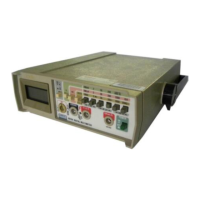HOW
TO USE
THE METER
Digital and
Analog
Displays
(15)
iiiililifiltiiitliiliMllllliiil
Analog Display
The analog
display is a 32-segment pointer that
updates at
a
40 times
per second rate and
is
the
best
display
to
use
for
readings that
are changing.
It
does
not operate in
the
Capacitance or Fre-
quency Counter
functions or in the
Peak
MIN
MAX
mode.
For increased sensitivity, the analog
pointer moves
across the scale four
times for each range. The
pointer returns
to (wraps around) when the
equivalent digital
display reaches
1024, 2048, and
3072 counts.
Select
the
next
higher
range
if the
pointer is too sensitive.
The analog pointer
indicates a value lower than
the
digital display
(up to
2.5%
of range). Examples
on
the
40V
range are:
Digital Display
=
5.00V
15.00V
25.00V 35.00V
Analog
Pointer
=
4.8 4.5 4.5
4.2
Wrap
=
First
Second
Third
Fourth
Indication
=
4.8V 14.5V
24.5V
34.2V
14
With stable
inputs,
use
the digital display for
the
best
sensitivity and
precision.
(16)
?„„l„.,f„.,?..„1„„f,„.?M.,L„?,,..?„..?
Analog
Display Scale
Scale for
each
1000 counts
in the
digital display.
±
Analog Display Polarity
Indicates
the polarity of the
input except in
the
Frequency
Counter mode,
when it indicates the
polarity of the trigger slope (edge).
Input Range Annunciator
Displays
4,
40,
400,
or
4,000
input range for volts,
amps, or ohms, and
400 mV.
Overload Indication
Displayed
on digital display when
input (or math
calculation in REL mode)
is too
large
to
display. If
you are taking
duty
cycle readings, OL is displayed
if the input signal stays
high
or
low. All
segments are
illuminated
on
analog
display.
Items
20-23
describe
annunciators that indicate
the mode or
state in which
the meter
is
operating:

